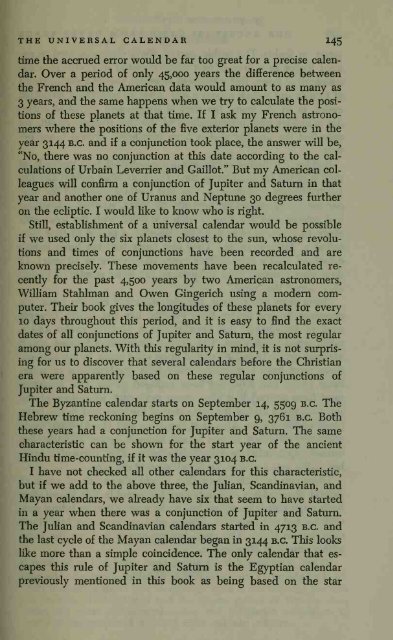You also want an ePaper? Increase the reach of your titles
YUMPU automatically turns print PDFs into web optimized ePapers that Google loves.
THE UNIVERSAL CALENDAR<br />
I45<br />
time the accrued error would be far too great for a precise calendar.<br />
Over a period of only 45,000 years the difference between<br />
the French and the American data would amount to as many as<br />
years, and the same happens when we try to calculate the posi-<br />
3<br />
tions of these planets at that time. If I ask my French astronomers<br />
where the positions of the five exterior planets were in the<br />
year 3144 B.C. and if a conjunction took place, the answer will be,<br />
"No, there was no conjunction at this date according to the calculations<br />
of Urbain Leverrier and Gaillot.'' But my American colleagues<br />
will confirm a conjunction of Jupiter and Saturn in that<br />
year and another one of Uranus and Neptune 30 degrees further<br />
on the ecliptic. I would like to know who is right.<br />
Still,<br />
establishment of a universal calendar would be possible<br />
if we used only the six planets closest to the sun, whose revolutions<br />
and times of conjunctions have been recorded and are<br />
known precisely. These movements have been recalculated recently<br />
for the past 4,500 years by two American astronomers,<br />
William Stahlman and Owen Gingerich using a modem computer.<br />
Their book gives the longitudes of these planets for every<br />
10 days throughout this period, and it is easy to find the exact<br />
dates of all conjunctions of Jupiter and Saturn, the most regular<br />
among our planets. With this regularity in mind, it is not surprising<br />
for us to discover that several calendars before the Christian<br />
era were apparently based on these regular conjunctions of<br />
Jupiter and Saturn.<br />
The Byzantine calendar starts on September 14, 5509 B.C. The<br />
Hebrew time reckoning begins on September 9, 3761 B.C. Both<br />
these years had a conjunction for Jupiter and Saturn. The same<br />
characteristic can be shown for the start year of the ancient<br />
Hindu time-counting, if it was the year 3104 B.C.<br />
I have not checked all other calendars for this characteristic,<br />
but if we add to the above three, the Julian, Scandinavian, and<br />
Mayan calendars, we already have six that seem to have started<br />
in a year when there was a conjunction of Jupiter and Saturn.<br />
The Julian and Scandinavian calendars started in 4713 B.C. and<br />
the last cycle of the Mayan calendar began in 3144 B.C. This looks<br />
like more than a simple coincidence. The only calendar that escapes<br />
this rule of Jupiter and Saturn is the Egyptian calendar<br />
previously mentioned in this book as being based on the star

















